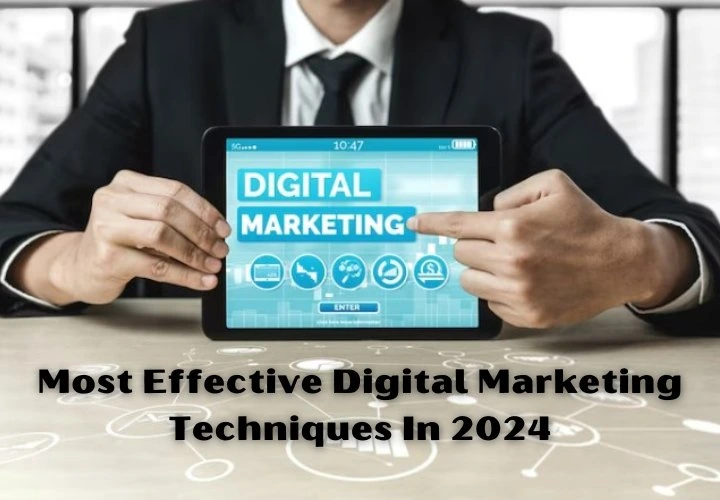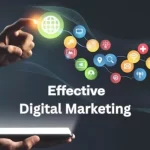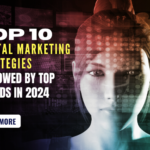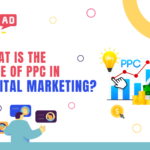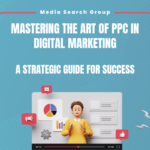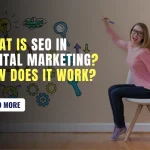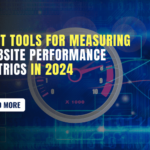Most Effective Digital Marketing Techniques In 2025
Recently updated: December 31st, 2024
As the digital world continues to evolve, businesses must adopt the most effective techniques to reach and engage their target audience. From personalized experiences and advanced technologies like augmented reality to the dominance of video content in advertising, there will be a diverse array of digital marketing techniques.
Many businesses experience significant success from digital marketing campaigns because they have found the most effective digital marketing techniques. They followed and learned everything about them, applied them, and got the desired results.
66% of marketers increased their company’s credibility and trust through digital marketing tactics.
In this guide, you will learn the most effective digital marketing techniques that marketers can use in 2025.
What is Digital Marketing?
Digital marketing refers to the utilization of digital technologies to market products and services. It has different aspects that can grow product identity and provide solutions for different problems.
Digital marketing aims to build brand awareness, drive traffic, generate leads, and strengthen customer relationships through targeted and personalized approaches. It relies on data-driven insights and analytics to optimize campaigns and measure performance metrics like engagement, conversions, and return on investment (ROI).
It involves digital channels like the Internet, social media, email, search engines, and mobile apps to reach, engage, and convert potential customers.
It encompasses various strategies, including content marketing, social media marketing, search engine optimization (SEO), email marketing, and paid advertising.
Digital marketing has the following features:
- Data-driven decision-making
- Enhanced customer relationships
- Expansion
- Flexibility
Benefits of Digital Marketing Techniques
Digital marketing techniques offer a wide range of benefits for businesses in almost all industries.
Here are some benefits of digital marketing techniques:
Global reach
Digital marketing allows businesses to reach a global audience. With online channels, you can connect with potential customers worldwide, expanding your market reach. This will help you increase your brand awareness and stability.
Cost-effective
Compared to traditional marketing methods, digital marketing can be more cost-effective. Platforms like social media and email marketing often have lower costs and can provide a high return on investment (ROI).
Targeted advertising
Digital marketing allows for precise targeting based on demographics, interests, behavior, and other criteria. This ensures that your marketing efforts are directed at the most relevant audience, increasing the chances of engagement and conversion.
Measurable results
Digital marketing provides extensive analytics and data-tracking tools. This allows businesses to measure the performance of their campaigns in real time, enabling them to make data-driven decisions and optimize strategies for better results.
Interactivity and engagement
Digital marketing channels enable two-way communication between businesses and their audience. Social media, comments, and feedback can facilitate engagement, enhancing a sense of community and brand loyalty.
Brand building and awareness
Digital marketing provides a platform for building and promoting brand awareness. Consistent online presence across various channels helps in establishing and improving brand identity.
Also Read: How Digital Marketing Helps Small And Medium Businesses?
Some of The Most Effective Digital Marketing Techniques
Digital marketing encompasses a wide range of techniques that are aimed at promoting products or services using digital channels.
Here are some key digital marketing techniques:
Search Engine Optimization
Search Engine Optimization (SEO) is a fundamental part of digital marketing, having advanced techniques that optimize a website’s visibility on search engines like Google, Bing, and Yahoo.
72% of online marketers describe content creation as their most effective SEO tactic.
The primary goal of SEO is to enhance a website’s organic search rankings, making it more searchable for users actively seeking relevant information, products, or services.
This process involves various on-page and off-page optimization techniques to improve the website’s structure, content, and overall structure.
Components of SEO:
- Keyword Research
Identifying and targeting specific keywords and phrases relevant to a business or industry is the foundation of effective SEO.
- On-Page Optimization
This involves optimizing individual web pages to improve their search rankings. Key elements include title tags, meta descriptions, header tags, etc.
- Off-Page Optimization
Off-page SEO focuses on external factors influencing a website’s visibility. This includes building high-quality backlinks from authentic websites, social media signals, and online.
- Technical SEO
Technical SEO deals with the technical aspects of a website, ensuring that search engine crawlers can efficiently index it. It involves optimizing site speed, fixing crawl errors, and implementing structured data markup.
Benefits of SEO:
- SEO efforts result in improved search engine rankings, leading to increased visibility.
- Businesses can reduce dependence on paid advertising by establishing a strong organic presence through effective SEO.
- Websites rank highly on search engine results pages (SERPs) and are often perceived as more credible and trustworthy by users.
Content Marketing
Content marketing is a strategic approach within the world of digital marketing that involves creating and distributing valuable, relevant, and consistent content to attract and engage a target audience.
This technique focuses on delivering information that is not fully promotional but aims to educate, entertain, or solve problems for the audience.
The goal is to build a relationship with the audience and ultimately drive profitable customer conversions.
Components of content marketing:
- Creation of quality content
Content marketing starts with the creation of high-quality and valuable content. This can take various forms, including blog posts, articles, videos, infographics, podcasts, and more.
- Distribution across channels
Once the content is created, it needs to be strategically distributed across various online platforms. This includes social media, websites, email newsletters, and other channels.
- Consistency and regular updates
Content marketing is not a one-time effort but a continuous process. Regular updates and the consistent delivery of valuable content help maintain audience engagement and build trust.
- Tracking analytics
Monitoring the performance of content is crucial for success. Marketers can track key metrics such as website traffic, engagement, and conversion rates through analytics tools.
Benefits of content marketing:
- Content marketing contributes significantly to building brand awareness. By consistently providing valuable content, businesses can establish themselves as authoritative and knowledgeable.
- Educational content helps in addressing the pain points and queries of the audience, positioning the brand as a helpful resource.
- Well-crafted content serves as a powerful tool for lead generation. By incorporating effective calls-to-action within the content, businesses can encourage users to take desired actions.
Also Read: Top 10 Digital Marketing Strategies Followed by Top Brands
Social Media Marketing
Social media marketing is an important component of digital marketing because it uses different social media platforms to connect with the target audience, build brand awareness, and promote products or services.
It is projected that $130.5 billion of total social media ad spending will be generated through mobile by 2027.
This strategy involves creating and sharing content on various social media channels to engage and interact with users.
Social media marketing aims to strengthen relationships, drive website traffic, and ultimately achieve business goals through the strategic use of platforms like Facebook, Instagram, Twitter, LinkedIn, and others.
Components of social media marketing:
- Content creation and sharing
Social media marketing begins with the creation of engaging and shareable content. This can include a mix of text, images, videos, and other multimedia formats created to the preferences of the target audience.
- Audience engagement and interaction
Active engagement is crucial in social media marketing. This involves responding to comments, messages and mentions properly. It also includes participating in discussions and running polls.
- Social media analytics
Monitoring and analyzing social media metrics is essential for measuring the effectiveness of marketing efforts. Analytics tools provide insights into reach, engagement, conversion rates, and other key performance indicators.
- Partnering with influencers
Individuals with a significant and engaged following on social media can amplify a brand’s reach and credibility. Influencers can help create authentic content and promote products or services to their followers.
Benefits of social media marketing:
- Social media platforms provide a vast and diverse audience. By consistently sharing compelling content, businesses can increase brand visibility and reach a broader audience.
- Social media allows brands to directly engage with their audience in real-time. Responding to comments and messages and participating in discussions helps build a community around the brand.
- Social media platforms offer diverse targeting options for advertising. Marketers can create their campaigns for specific demographics, interests, and behaviors.
Also Read: Why Do Small Businesses Need Digital Marketing?
Email Marketing
Email marketing is a highly active digital marketing technique that involves sending targeted messages and promotional content to a specific audience through email channels.
On average, email marketing has a 4400% ROI.
This strategy aims to build and nurture relationships with potential and existing customers, promote products or services, and drive engagement.
Email marketing is versatile, cost-effective, and allows businesses to communicate directly with their audience, making it a valuable tool for achieving various marketing objectives.
Components of email marketing:
- Building and managing email lists
The foundation of email marketing lies in the creation and management of email lists. Businesses collect email addresses from interested individuals through website sign-ups, events, or other means.
- Creating compelling email content
Content is crucial in email marketing. Messages should be engaging and relevant to provide value to the recipients. Content can include promotional offers, product updates, educational content, newsletters, and more.
- Personalization and segmentation
Personalization is a key aspect of effective email marketing. By creating content based on user preferences, behavior, or demographics, marketers can create a more personalized and engaging experience.
- Automation and email campaigns
Email marketing often involves the use of automation tools to streamline and optimize campaigns. Automation allows for the creation of campaigns and triggered emails.
Benefits of email marketing:
- Email marketing allows businesses to communicate directly with their audience in a personalized manner. By addressing customers’ names and creating content, email campaigns create a strong connection.
- Compared to many other digital marketing channels, email marketing is more cost-effective. There are minimal expenses associated with designing.
- The ability to segment email lists and create targeted campaigns is a significant advantage. Marketers can deliver messages to specific audience segments, ensuring that content is relevant to customers.
Pay-per-click advertising
Paid advertising in digital marketing, specifically Pay-Per-Click (PPC), is a prominent digital marketing technique where advertisers pay a fee each time their ad is clicked.
PPC campaigns are often run on search engines, social media platforms, and other online channels. This method provides businesses with a direct and targeted approach to reaching their audience, allowing for increased visibility and potential conversions.
Components of paid advertising (PPC):
- Ad creation
Crafting compelling and relevant ads is essential in PPC advertising. Advertisers create ad copies, including headlines, descriptions, and display URLs, to compel users to click.
- Bid management
Bidding involves determining the maximum amount an advertiser is willing to pay for a click on their ad. Bid management is an ongoing process where advertisers monitor the performance of keywords and adjust bids accordingly.
- Targeting options
PPC platforms offer various targeting options to ensure ads reach the right audience. This includes geographic targeting, demographic targeting, device targeting, and more.
- Ad extensions
Ad extensions provide additional information to users and enhance the visibility of ads. These extensions may include site links, callout extensions, location extensions, and more.
Benefits of paid advertising (PPC):
- Once a campaign is launched, ads can appear on search engine results pages or social media platforms immediately.
- PPC campaigns offer precise control over advertising costs. Advertisers set budgets, and the pay-per-click model ensures that costs are directly tied to actual clicks.
- PPC allows for highly targeted advertising, ensuring that ads are shown to users who are actively searching for relevant products or services.
- PPC campaigns provide advertisers with a high level of flexibility and control.
Also Read: How Can Advertising Be Effective Through Digital Marketing?
Video Marketing
Video marketing is a huge digital marketing technique that involves the creation, distribution, and promotion of video content to engage, educate, and encourage a target audience.
86% of video marketers say video has helped them increase web traffic.
With the rise of online video consumption, platforms like YouTube, Facebook, Instagram, and TikTok have become powerful channels for businesses to connect with their audience through visual storytelling.
Video marketing encompasses a variety of formats, including promotional videos, tutorials, testimonials, vlogs, and more.
Components of video marketing:
- Content creation
Video marketing starts with the creation of compelling and relevant video content, often made easier with the use of an online video editor tool. This may include product demonstrations, how-to guides, storytelling narratives, or any content that aligns with the brand’s goals.
- Platform Selection
Different platforms manage diverse audiences and content styles. Video marketers need to choose platforms strategically based on their target demographic and the nature of the content.
- Distribution and promotion
Once video content is created, it needs to be effectively distributed and promoted. This involves sharing videos on various social media channels, embedding them on websites, and utilizing email marketing or paid advertising to expand reach.
- Audience interaction
Responding to comments, encouraging discussions, and fostering a sense of community around the video content can enhance brand loyalty.
Benefits of video marketing:
- Video content is inherently more engaging than text or static images. It captures the viewer’s attention and conveys information more effectively.
- Video marketing is a powerful tool for increasing brand visibility. Engaging videos that align with the brand’s identity and values helps build brand recognition.
- Search engines, particularly Google, prioritize video content in search results.
Mobile Marketing
Mobile marketing is a digital marketing strategy focused on reaching and engaging target audiences through mobile devices, such as smartphones and tablets.
51% of shoppers have completed an online purchase with a smartphone.
With the increasing use of mobile devices and their growing reliability for various activities, mobile marketing has become an essential component of overall digital marketing strategies.
This technique encompasses a range of channels and tactics, including mobile apps, SMS marketing, mobile-optimized websites, in-app advertisements, and location-based marketing.
Components of mobile marketing:
- Mobile apps
Creating and promoting mobile applications is a key aspect of mobile marketing. Businesses develop apps to provide value to users, improve user experience, and encourage regular engagement.
- SMS marketing
SMS marketing involves sending text messages to mobile users with promotional content, offers, or important updates. This direct communication method can be highly effective for promotions, reminders, and engaging customers.
- Mobile-optimized websites
With the increasing use of smartphones for browsing, having a mobile-optimized website is crucial. Mobile-friendly websites ensure a seamless and user-friendly experience for visitors.
- In-app advertising
Many users spend a significant amount of time within mobile applications. In-app advertising involves displaying ads within mobile apps to reach an audience. This can include banner ads, native ads, or video ads.
Benefits of mobile marketing:
- Mobile marketing allows businesses to reach a vast and diverse audience, ensuring that marketing messages can reach users in various locations.
- Mobile marketing enables personalized and targeted communication with users. Through data analysis and user profiling, marketers can deliver content that is relevant to individual preferences.
- Mobile-friendly experiences contribute to higher conversion rates. When users have a seamless and enjoyable experience on mobile websites or apps, they are more likely to take desired actions.
Also Read: Why Do Small Businesses Fail At Digital Marketing?
Implement the Most Effective Digital Marketing Techniques
As we studied the digital marketing techniques for 2025, we got a clear overview of their components and benefits. The most effective strategies are those that embrace innovation, adaptability, and a deep understanding of the ever-evolving digital world.
These techniques are very beneficial for every size of business in the market. The success lies in making campaigns by using these techniques in the right way to connect with the audience.
To implement these cutting-edge digital marketing techniques effectively, all sizes of businesses can explore scalable and budget-friendly digital marketing pricing packages from startups to comprehensive plans for established enterprises that align with the latest digital marketing trends.
Businesses that embrace these methodologies have strong interactivity, high brand engagement, and personalized communication, which enhances the expectations of a digitally empowered audience.
Hopefully, you all get to understand these digital marketing techniques through this blog. The most effective digital marketing techniques in 2025 have the importance of agility, innovation, and a customer-centric approach for addressing the complexities of the digital marketplace.
Latest posts by Vijaya Tyagi (see all)
How To Track Shopify SEO Performance & Metrics (2025) - January 14, 2025
Link Building Strategies: The Ultimate Techniques for 2025 - December 31, 2024


